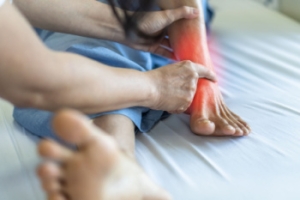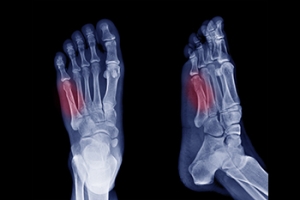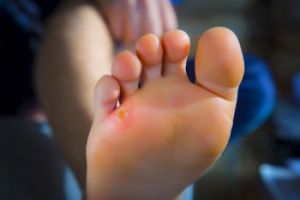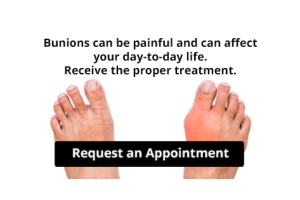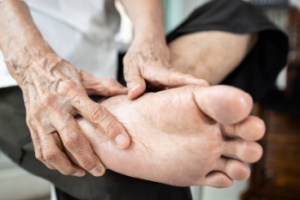
What to Do to Keep Your Child’s Feet Healthy
Being a parent involves caring for your child in every way you can. You make sure they are eating the right food, being nice to others, and staying out of any trouble. However, it is also important that you are watchful of their health, more specifically their foot health. Maintaining good foot health in childhood is important in preventing later conditions in life from happening. As children continue to develop, their feet require different techniques of care. Here are some various ways in which you can help your child’s feet stay healthy.
A baby needs a lot of care and attention overall, but the importance of their feet should never be forgotten. Before a baby turns one, their feet change and develop greatly. It is important that during this time, a mother avoids putting tight socks on their child. She should also encourage movement of their feet so the baby can begin to feel more comfortable using them.
As a baby enters the toddler years of his or her life, they are begin to walk around. When your baby begins to take those first steps, it is crucial that they are wearing protective shoes on their feet. As a mother that is observant of your child’s feet, you may notice changes in them. This is completely normal as the feet are becoming susceptible to the activity of walking. It is normal for a toddler to be a bit unsteady or to “walk funny” at first.
When your child grows out of their toddler years, it is important that you begin to show him or her how to care for their feet on their own. Practice with your child proper hygiene in order to prevent foot fungus or infection. Since children are constantly on the move, it is crucial to be cautious of any accidents or injuries that might occur. If an injury occurs, it is advised that you take your child to be examined by a doctor immediately. Since your child is still growing, particular injuries can shift the way in which a bone or other important part of the foot is developing.
Babies and kids are always changing and growing. Your job as a parent is to make sure they stay healthy and making sure they are properly maintained. This involves proper foot care and making sure the feet stay healthy. Following this guide, your child can live a long and happy life.
What Does Tarsal Tunnel Syndrome Feel Like?
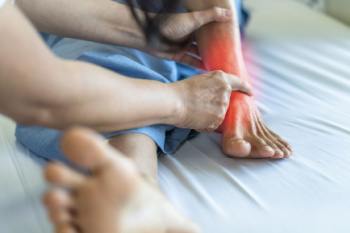 Tarsal tunnel syndrome is caused by compression of the posterior tibial nerve as it passes through the tarsal tunnel, which is a narrow space on the inside of the ankle. This nerve entrapment can result overuse, injury, inflammation, or structural abnormalities, such as flat feet or varicose veins. Symptoms of tarsal tunnel syndrome include tingling, burning, or shooting pain in the foot and ankle, numbness, and a feeling of electric shocks radiating into the sole. These symptoms often worsen with prolonged standing or walking. Diagnosis involves a physical examination, focusing on the areas of pain and nerve compression, in addition to imaging studies like MRI scans or ultrasounds to identify underlying causes. Nerve conduction studies may also be used to assess the function of the posterior tibial nerve. Relief options include rest, anti-inflammatory medications, and exercises to alleviate symptoms. Orthotic devices can help reduce pressure on the nerve, and in severe cases, surgical intervention may be necessary. Complications from untreated tarsal tunnel syndrome can lead to chronic pain and permanent nerve damage. If you have pain in this part of your foot, it is suggested that you schedule an appointment with a podiatrist for a precise diagnosis and individualized treatment plan.
Tarsal tunnel syndrome is caused by compression of the posterior tibial nerve as it passes through the tarsal tunnel, which is a narrow space on the inside of the ankle. This nerve entrapment can result overuse, injury, inflammation, or structural abnormalities, such as flat feet or varicose veins. Symptoms of tarsal tunnel syndrome include tingling, burning, or shooting pain in the foot and ankle, numbness, and a feeling of electric shocks radiating into the sole. These symptoms often worsen with prolonged standing or walking. Diagnosis involves a physical examination, focusing on the areas of pain and nerve compression, in addition to imaging studies like MRI scans or ultrasounds to identify underlying causes. Nerve conduction studies may also be used to assess the function of the posterior tibial nerve. Relief options include rest, anti-inflammatory medications, and exercises to alleviate symptoms. Orthotic devices can help reduce pressure on the nerve, and in severe cases, surgical intervention may be necessary. Complications from untreated tarsal tunnel syndrome can lead to chronic pain and permanent nerve damage. If you have pain in this part of your foot, it is suggested that you schedule an appointment with a podiatrist for a precise diagnosis and individualized treatment plan.
Tarsal tunnel syndrome can be very uncomfortable to live with. If you are experiencing tarsal tunnel syndrome, contact one of our podiatrists of Foot Doctors of Utica. Our doctors can provide the care you need to keep you pain-free and on your feet.
Tarsal Tunnel Syndrome
Tarsal tunnel syndrome, which can also be called tibial nerve dysfunction, is an uncommon condition of misfiring peripheral nerves in the foot. The tibial nerve is the peripheral nerve in the leg responsible for sensation and movement of the foot and calf muscles. In tarsal tunnel syndrome, the tibial nerve is damaged, causing problems with movement and feeling in the foot of the affected leg.
Common Cause of Tarsal Tunnel Syndrome
- Involves pressure or an injury, direct pressure on the tibial nerve for an extended period of time, sometimes caused by other body structures close by or near the knee.
- Diseases that damage nerves, including diabetes, may cause tarsal tunnel syndrome.
- At times, tarsal tunnel syndrome can appear without an obvious cause in some cases.
The Effects of Tarsal Tunnel Syndrome
- Different sensations, an afflicted person may experience pain, tingling, burning or other unusual sensations in the foot of the affected leg.
- The foot muscles, toes and ankle become weaker, and curling your toes or flexing your foot can become difficult.
- If condition worsens, infections and ulcers may develop on the foot that is experiencing the syndrome.
A physical exam of the leg can help identify the presence of tarsal tunnel syndrome. Medical tests, such as a nerve biopsy, are also used to diagnose the condition. Patients may receive physical therapy and prescriptive medication. In extreme cases, some may require surgery.
If you have any questions please feel free to contact our offices located in Herkimer, and New Hartford, NY . We offer the newest diagnostic and treatment technologies for all your foot and ankle needs.
The Role of Podiatrists in Foot Health

Podiatrists are medical professionals specializing in the diagnosis, treatment, and prevention of conditions affecting the feet, ankles, and lower limbs. These doctors play a critical role in maintaining foot health and addressing a wide range of foot-related issues. Podiatrists treat various conditions, including ingrown toenails, plantar fasciitis, and bunions, in addition to corns, calluses, heel pain, and foot deformities. During an appointment with a podiatrist, patients can expect a thorough examination of their feet, ankles, and lower legs to assess their condition and identify any underlying issues. Depending on the diagnosis, treatment options may include custom orthotic devices, medication, or minimally invasive procedures. Podiatrists also provide guidance on proper foot care, footwear selection, and preventive measures to promote overall foot health and prevent future problems. With their specialized knowledge and expertise, podiatrists help patients maintain mobility, alleviate discomfort, and achieve optimal foot function. If you are experiencing any type of foot or ankle pain, it is strongly suggested that you visit a podiatrist who can make an accurate diagnosis and provide the necessary treatment.
If you are experiencing pain in the feet or ankles, don’t join the stubborn majority refusing treatment. Feel free to contact one of our podiatrists from Foot Doctors of Utica. Our doctors can provide the care you need to keep you pain-free and on your feet.
What Is a Podiatrist?
Someone would seek the care of a podiatrist if they have suffered a foot injury or have common foot ailments such as heal spurs, bunions, arch problems, deformities, ingrown toenails, corns, foot and ankle problems, etc.
Podiatric Treatment
A podiatrist will treat the problematic areas of the feet, ankle or lower leg by prescribing the following:
- Physical therapy
- Drugs
- Orthotic inserts or soles
- Surgery on lower extremity fractures
A common podiatric procedure a podiatrist will use is a scanner or force plate which will allow the podiatrist to know the designs of orthotics. Patients are then told to follow a series of tasks to complete the treatment. The computer will scan the foot a see which areas show weight distribution and pressure points. The podiatrist will read the analysis and then determine which treatment plans are available.
If you have any questions please feel free to contact our offices located in Herkimer, and New Hartford, NY . We offer the newest diagnostic and treatment technologies for all your foot and ankle needs.
What is a Podiatrist?
The branch of medicine that is focused on the treatment, diagnosis, and study of disorders of the lower leg, ankle and foot is referred to as podiatry. Because people often spend a great deal of their time on their feet, many problems in this area can occur. A person seeks help from the field of podiatry when they need treatment for heel spurs, bunions, arch problems, deformities, ingrown toenails, corns, foot and ankle problems, infections, and problems with the foot that are related to diabetes and additional diseases.
To treat problems of the foot, ankle or lower leg, a podiatrist may prescribe physical therapy, drugs, perform surgery, or set fractures. Individuals may also be recommended to wear corrective shoe inserts, custom-made shoes, plaster casts and strappings in order to correct deformities.
When trying to gather information on a patient problem, a scanner or force plate may be used in order to design orthotics. During this procedure, patients are told to walk across a plate that is connected to a computer; the computer then takes a scan of the foot and indicates weight distribution and pressure points. The computer readouts will give the podiatrist information to help them determine the correct treatment plans.
Diagnosis is also provided through laboratory tests and x-rays. Through the foot, the first signs of serious problems such as heart disease, diabetes and arthritis can show up. For example, individuals that have diabetes may frequently have problems such as infections and foot ulcers because they experience poor circulation in the foot area. A podiatrist can then have consultations with patients when symptoms arise. Referrals will then be made to specialists that handle the greater health problems.
Some podiatrists have their own independent, private practices or clinics where they have a small staff and administrative personnel. Many podiatrists work within group practices. They usually spend time performing surgery in ambulatory surgical centers or hospitals, or visit patients in nursing homes. Podiatrists typically spend between 30 to 60 hours of week working. Some podiatrists specialize in public health, orthopedics, surgery, or primary care. Other fields include specialties in geriatrics, dermatology, pediatrics, diabetic foot care and sports medicine.
Some podiatrist specialists complete extra training in the area of foot and ankle reconstruction that results from the effects of physical trauma or diabetes. There are also surgeons that perform surgery of a cosmetic nature to correct bunions and hammertoes.
Symptoms of a Jones Fracture
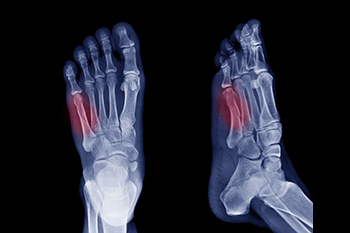
A Jones fracture occurs in the fifth metatarsal bone of the foot and has distinct symptoms that necessitate prompt medical attention. Typically caused by a severe direct impact, this avulsion fracture involves the tearing away of a bone fragment by tendons or muscles. Acute pain is often the primary indicator of a Jones fracture, and individuals experiencing persistent pain at the base of the foot should seek immediate medical attention. Other symptoms associated with a Jones fracture include swelling, bruising, and impaired movement of the little toe. Contrary to common belief, movement may still be possible despite the fracture, but will be accompanied by significant pain. Impaired balance also can signal a potential Jones fracture, highlighting the importance of recognizing all symptoms. Swelling, typically localized around the fifth metatarsal bone and pinky toe is another indication of the likelihood of a Jones fracture. Typically, Jones fractures require approximately six to eight weeks to heal properly, and the foot may be immobilized in a cast during this period to promote optimal healing. If you suspect you may have sustained a Jones fracture, it is suggested that you make an emergency appointment with a podiatrist for a thorough evaluation, including X-rays, and appropriate treatment.
A broken foot requires immediate medical attention and treatment. If you need your feet checked, contact one of our podiatrists from Foot Doctors of Utica. Our doctors can provide the care you need to keep you pain-free and on your feet.
Broken Foot Causes, Symptoms, and Treatment
A broken foot is caused by one of the bones in the foot typically breaking when bended, crushed, or stretched beyond its natural capabilities. Usually the location of the fracture indicates how the break occurred, whether it was through an object, fall, or any other type of injury.
Common Symptoms of Broken Feet:
- Bruising
- Pain
- Redness
- Swelling
- Blue in color
- Numbness
- Cold
- Misshapen
- Cuts
- Deformities
Those that suspect they have a broken foot shoot seek urgent medical attention where a medical professional could diagnose the severity.
Treatment for broken bones varies depending on the cause, severity and location. Some will require the use of splints, casts or crutches while others could even involve surgery to repair the broken bones. Personal care includes the use of ice and keeping the foot stabilized and elevated.
If you have any questions please feel free to contact our offices located in Herkimer, and New Hartford, NY . We offer the newest diagnostic and treatment technologies for all your foot and ankle needs.
Causes, Symptoms, and Treatment for a Broken Foot
One out of ten broken bones is reported to be in the feet. When an object crushes, bends, or stretches the bone beyond acceptable ranges, bones break. A break in the foot is either a fracture or a straight break.
The location of any break can tell you how the break happened. Toes, for instance, break typically as a result of something being kicked hard and with great force. Heel breaks almost always are a result of an improper landing from a tall height. Twists or sprains are the other two frequent occurrences. As with all usual breaks, they result from unexpected accident or sudden injury. As with stress fractures, breaks form as a process over time from repeated stress on already present cracks. Runners, dancers, and gymnasts are the usual athletes who receive this type of break. Stress fractures result from incredible pressure on the feet. It is no surprise these athletes bear the majority of reported fractures.
Pain, swelling, bruising, and redness are all indicative of the typical symptoms from a broken foot. Severe pain—to the point of not being able to walk—usually depends on the location of the break in the foot. Toes are on the lower scale of pain threshold, but heels are high, as are a few other particular bones. As the severity of the broken foot increases, symptoms like blueness, numbness, misshaping of the foot, cuts, or deformities will become apparent. These symptoms indicate the need to see a medical professional with access to an x-ray facility.
Prior to seeing a specialist, precautions should be taken to reduce pain and swelling. Elevate and stabilize the foot, and refrain from moving it. Immobilization of the foot is the next priority, so creating a homemade splint is acceptable. Keep in mind that while creating a splint, any increase of pain or cutting off blood circulation means that the splint should be removed immediately. Use ice to decrease swelling and relieve pain symptoms.
When dealing with a medical center, the patient should note that the treatment can vary. The treatment will depend on the severity of the fracture and the cause of the break. Crutches, splits, or casts are common treatments while surgery has been known to be used in more severe cases in order to repair the break in the bones.
Causes and Relief Solutions for Corns
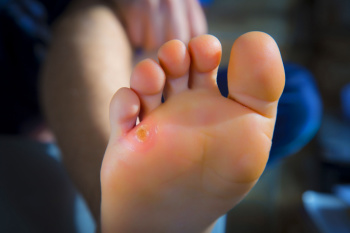
Corns, commonly found on the feet, are thickened areas of skin that develop in response to repeated friction or pressure. They typically appear on weight-bearing areas like the toes, soles, or sides of the feet, where friction from footwear or underlying bone abnormalities occurs. Corns may present as hard or soft, depending on their location and the presence of moisture. While they are generally harmless, they can cause discomfort, pain, and even inflammation if left untreated. Relief solutions for corns often involve alleviating pressure and reducing friction in affected areas. Wearing properly fitting footwear with ample toe room and cushioning can help prevent corns from worsening. Additionally, using protective pads or inserts can provide padding and reduce friction. In more severe cases, seeking professional assistance from a podiatrist may be necessary for safe and effective removal of corns. Having a corn on the foot can be uncomfortable. If you have developed a corn, it is suggested that you visit a podiatrist who can provide you with effective relief and prevention tips.
If you have any concerns regarding your feet and ankles, contact one of our podiatrists of Foot Doctors of Utica. Our doctors will treat your foot and ankle needs.
Corns: What Are They? and How Do You Get Rid of Them?
Corns can be described as areas of the skin that have thickened to the point of becoming painful or irritating. They are often layers and layers of the skin that have become dry and rough, and are normally smaller than calluses.
Ways to Prevent Corns
There are many ways to get rid of painful corns such as wearing:
- Well-fitting socks
- Comfortable shoes that are not tight around your foot
- Shoes that offer support
Treating Corns
Treatment of corns involves removing the dead skin that has built up in the specific area of the foot. Consult with Our doctors to determine the best treatment option for your case of corns.
If you have any questions, please feel free to contact our offices located in Herkimer, and New Hartford, NY . We offer the newest diagnostic and treatment technologies for all your foot care needs.
Corns: What Are They, and How Do You Get Rid of Them
Corns are thickened areas on the skin’s surface, to the point of being irritating and sometimes painful. Commonly found on the feet, corns are circular or cone-shaped. They develop where there are areas of pressure or friction, such as on the little toe when it rubs up against shoes, or on the ball of your foot.
Corns are often confused with a callus, but there is a difference between them. Corns can be raised bumps that are painful to the touch. They consist of a rough, thick area of skin that may be dry or waxy. Corns tend to be surrounded by skin that is inflamed, and are usually much smaller than calluses.
Removing the dead skin that has built up is the key in treating corns. Salicylic acid medication is most common in accomplishing this. The acid works by dissolving keratin, which is the protein that makes up the majority of corns. You can purchase salicylic acid over-the-counter in products such as wart removers. It comes in a variety of forms such as medicated pads, drops, or creams. However, people who are diabetic should not use salicylic acid, but should instead consult their doctor immediately.
According to the product directions, applying the medication directly onto the corn will treat it. The top layer of the corn will begin to turn white after use. When that occurs, the layers of skin can then be peeled away, making the corn smaller. Shaving off corns with razors or other pedicure equipment is never a good idea. This can lead to infection. If your corn gets infected, and is not treated immediately, a visit to the doctor will be necessary.
Another way to treat corns and help prevent their return is by using orthotic inserts, fitted by a podiatrist. Inserts fit right into your shoes and adjusts the way your foot fits into your shoes. This fixes the way you walk. This will lower your chances of getting corns, and eliminate current corns by reducing rubbing from friction.
Surgery is rarely used to treat corns, but does occur on occasion. Surgery actually deals with the underlying issue that causes corns. During surgery, the bone is shaved and any abnormalities are corrected, thus reducing the amount of friction that occurs during walking.
To prevent corns, the first step is reducing friction. Always wear shoes that fit well and don’t rub your feet. Pads can be purchased if you notice rubbing developing. These pads can be purchased over-the-counter, and can be simply placed on the irritated area. Wearing cushioned insoles in your shoes can always reduce the friction, and making sure to wear well-fitting shoes. This will ensure that your foot is not being squeezed awkwardly, and prevent corns from forming in the first place.
Are Bunions Affecting Your Everyday Life?
Rheumatoid Arthritis and Foot Health
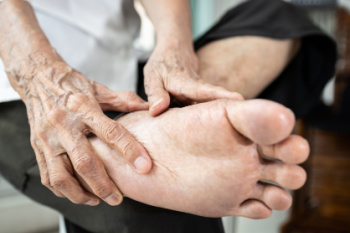
Rheumatoid arthritis, or RA, is a chronic autoimmune condition that can affect various joints throughout the body, including those in the feet and ankles. In RA, the joints become inflamed, leading to pain, swelling, stiffness, and loss of function. Several foot and ankle joints commonly affected by RA include the metatarsophalangeal, or MTP joints, which connect the toes to the foot bones, as well as the subtalar and ankle joints. Inflammation in these joints can cause deformities, such as bunions, hammertoes, and flat feet, that make walking and standing difficult. Additionally, RA can lead to the formation of rheumatoid nodules, which are firm lumps that develop under the skin, often surrounding the Achilles tendon or on the toes. Prompt diagnosis and treatment are essential for managing RA symptoms and preventing joint damage. If you are experiencing stiffness in your feet or ankles, it is suggested that you schedule an appointment with a podiatrist who can suggest treatment options.
Because RA affects more than just your joints, including the joints in your feet and ankles, it is important to seek early diagnosis from your podiatrist if you feel like the pain in your feet might be caused by RA. For more information, contact one of our podiatrists of Foot Doctors of Utica. Our doctors will assist you with all of your podiatric concerns.
What Is Rheumatoid Arthritis?
Rheumatoid Arthritis (RA) is an autoimmune disorder in which the body’s own immune system attacks the membranes surrounding the joints. Inflammation of the lining and eventually the destruction of the joint’s cartilage and bone occur, causing severe pain and immobility.
Rheumatoid Arthritis of the Feet
Although RA usually attacks multiple bones and joints throughout the entire body, almost 90 percent of cases result in pain in the foot or ankle area.
Symptoms
- Swelling and pain in the feet
- Stiffness in the feet
- Pain on the ball or sole of feet
- Joint shift and deformation
Diagnosis
Quick diagnosis of RA in the feet is important so that the podiatrist can treat the area effectively. Your doctor will ask you about your medical history, occupation, and lifestyle to determine the origin of the condition. Rheumatoid Factor tests help to determine if someone is affected by the disease.
If you have any questions please feel free to contact our offices located in Herkimer, and New Hartford, NY . We offer the newest diagnostic and treatment technologies for all your foot and ankle needs.
